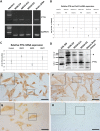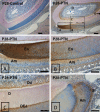Pleiotrophin expression during odontogenesis
- PMID: 22382872
- PMCID: PMC3351233
- DOI: 10.1369/0022155412439316
Pleiotrophin expression during odontogenesis
Abstract
Pleiotrophin (PTN) is an extracellular matrix-associated growth factor and chemokine expressed in mesodermal and ectodermal cells. It plays an important role in osteoblast recruitment and differentiation. There is limited information currently available about PTN expression during odontoblast differentiation and tooth formation, and thus the authors aimed to establish the spatiotemporal expression pattern of PTN during mouse odontogenesis. Immortalized mouse dental pulp (MD10-D3, MD10-A11) and odontoblast-like (M06-G3) and ameloblast-like (EOE-3M) cell lines were grown and samples prepared for immunocytochemistry, Western blot, and conventional and quantitative PCR analysis. Effects of BMP2, BMP4, and BMP7 treatment on PTN expression in odontoblast-like M06-G3 cells were tested by quantitative PCR. Finally, immunohistochemistry of sectioned mice mandibles and maxillaries at developmental stages E16, E18, P1, P6, P10, and P28 was performed. The experiments showed that PTN, at both the mRNA and protein level, was expressed in all tested epithelial and mesenchymal dental cell lines and that the level of PTN mRNA was influenced differentially by the bone morphogenetic proteins. The authors observed initial expression of PTN in the inner enamel epithelium with prolonged expression in the ameloblasts and odontoblasts throughout their stages of maturation and strong expression in the terminally differentiated and enamel matrix-secreting ameloblasts and odontoblasts of the adult mouse incisors and molars.
Conflict of interest statement
The authors declared no potential conflicts of interest with respect to the research, authorship, and/or publication of this article.
Figures





Similar articles
-
Epiprofin Regulates Enamel Formation and Tooth Morphogenesis by Controlling Epithelial-Mesenchymal Interactions During Tooth Development.J Bone Miner Res. 2017 Mar;32(3):601-610. doi: 10.1002/jbmr.3024. Epub 2016 Dec 27. J Bone Miner Res. 2017. PMID: 27787957
-
Expression of clock proteins in developing tooth.Gene Expr Patterns. 2011 Mar-Apr;11(3-4):202-6. doi: 10.1016/j.gep.2010.12.002. Epub 2010 Dec 13. Gene Expr Patterns. 2011. PMID: 21156215 Free PMC article.
-
The expression pattern of FHL2 during mouse molar development.J Mol Histol. 2012 Jun;43(3):289-95. doi: 10.1007/s10735-012-9409-z. Epub 2012 Mar 30. J Mol Histol. 2012. PMID: 22461197
-
Expression of the mRNA for types I and II interleukin-1 receptors in dental tissues of mice during tooth development.Calcif Tissue Int. 1998 Oct;63(4):351-6. doi: 10.1007/s002239900539. Calcif Tissue Int. 1998. PMID: 9744996
-
Expression of CPNE7 during mouse dentinogenesis.J Mol Histol. 2019 Jun;50(3):179-188. doi: 10.1007/s10735-019-09816-0. Epub 2019 Mar 12. J Mol Histol. 2019. PMID: 30863901
Cited by
-
Integrated analysis of DNA methylome and transcriptome reveals the differences in biological characteristics of porcine mesenchymal stem cells.BMC Genom Data. 2021 Dec 18;22(1):56. doi: 10.1186/s12863-021-01016-8. BMC Genom Data. 2021. PMID: 34922435 Free PMC article.
-
The evolution of hominin bipedalism in two steps.Nature. 2025 Aug 27. doi: 10.1038/s41586-025-09399-9. Online ahead of print. Nature. 2025. PMID: 40866708
-
Increased Pleiotrophin Concentrations in Papillary Thyroid Cancer.PLoS One. 2016 Feb 25;11(2):e0149383. doi: 10.1371/journal.pone.0149383. eCollection 2016. PLoS One. 2016. PMID: 26914549 Free PMC article.
-
Elevated expression of pleiotrophin in human hypertrophic scars.J Mol Histol. 2013 Feb;44(1):91-6. doi: 10.1007/s10735-012-9453-8. Epub 2012 Sep 28. J Mol Histol. 2013. PMID: 23054143
-
Prostate cancer derived prostatic acid phosphatase promotes an osteoblastic response in the bone microenvironment.Clin Exp Metastasis. 2014 Feb;31(2):247-56. doi: 10.1007/s10585-013-9625-2. Epub 2013 Nov 17. Clin Exp Metastasis. 2014. PMID: 24242705 Free PMC article.
References
-
- Arai H, Higuchi S, Muramatsu T, Iwatsubo T, Sasaki H, Trojanowski JQ. 1994. Apolipoprotein E gene in diffuse Lewy body disease with or without co-existing Alzheimer’s disease. Lancet. 344(8932):1307 - PubMed
-
- Bernard-Pierrot I, Heroult M, Lemaitre G, Barritault D, Courty J, Milhiet PE. 1999. Glycosaminoglycans promote HARP/PTN dimerization. Biochem Biophys Res Commun. 266(2):437–442 - PubMed
-
- Deuel TF, Zhang N, Yeh HJ, Silos-Santiago I, Wang ZY. 2002. Pleiotrophin: a cytokine with diverse functions and a novel signaling pathway. Arch Biochem Biophys. 397(2):162–171 - PubMed
-
- Hamma-Kourbali Y, Bernard-Pierrot I, Heroult M, Dalle S, Caruelle D, Milhiet PE, Fernig DG, Delbe J, Courty J. 2008. Inhibition of the mitogenic, angiogenic and tumorigenic activities of pleiotrophin by a synthetic peptide corresponding to its C-thrombospondin repeat-I domain. J Cell Physiol. 214(1):250–259 - PubMed
-
- Hikake T, Mori T, Iseki K, Hagino S, Zhang Y, Takagi H, Yokoya S, Wanaka A. 2003. Comparison of expression patterns between CREB family transcription factor OASIS and proteoglycan core protein genes during murine tooth development. Anat Embryol (Berl). 206(5):373–380 - PubMed
Publication types
MeSH terms
Substances
Grants and funding
LinkOut - more resources
Full Text Sources
Other Literature Sources
Molecular Biology Databases
Research Materials

